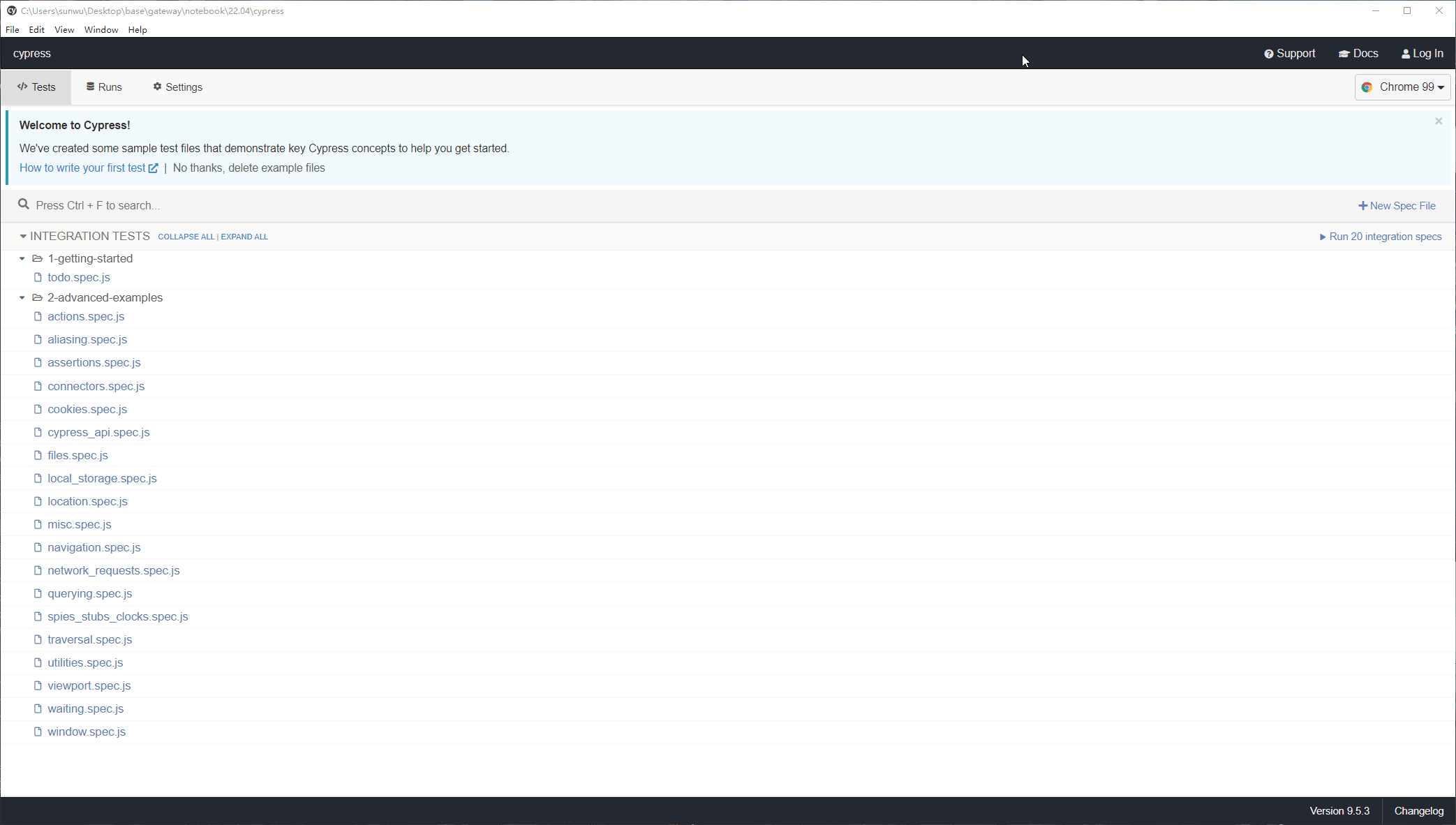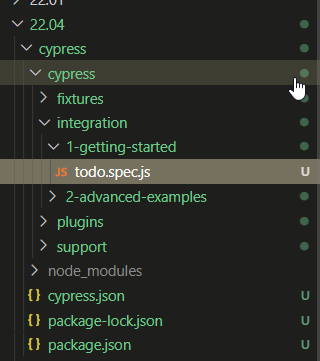cypress
cypress和selenium一样都是基于浏览器的自动化测试工具,两者各有特点。cypress最大的特点就是环境非常简单,支持js语言,并且GUI非常好看。
selenium则是历史悠久,工业规范,多语言支持,尤其是支持Python。
安装与运行
npm i --save cypress
npx cypress open

框架与语法简介
在当前目录运行cypress open之后会生成下图这样的目录结构(也可以在当前仓库看到。)
有一个cypress.json是存储基础的配置的,例如常用来存储host,exclude test等。
有一个cypress目录,其中有个integration目录是用来存储集成测试的test case脚本的,所有的js文件必须以.spec.js来结尾才会被cypress识别为测试脚本

测试脚本的语法可以参考提供的todo.spec.js如下,第一行是必须的,然后所有的测试都在一个describe函数的回调中运行,因为有第一行的引入,在当前js上下文中是可以使用cypress提供的函数和变量的,
例如beforeEach函数就是在接下来每个it测试场景之前都会执行的操作。
cy.visit是当前浏览器指定访问一个url。
cy.get类似jQuery的选取dom,得到一个或多个dom元素,dom元素支持的常见方法:
- should('have.text', 'xxx') 判断内部文字
- click() 点击
- type('xx') 输入文字
cy.get.contains用于辅助锁定dom元素。
核心秘诀
- Cypress.$等于jquery的$,是内嵌了jQuery。但是不要visit之后上来就用,因为页面还没加载出来。
- cy的函数基本都是异步的,在context第一行定义一个
getText的异步函数,然后在visit之后先getText一下。 - 本目录下cypress项目
cypress/integration/1-getting-started/youdao.spec.js展示了如何进行爬虫,非常实用。
let jq = Cypress.$;
let getText = async (node) => {
return await new Promise((t,c) => {
node.invoke('text').then(t)
})
}
/// <reference types="cypress" />
// Welcome to Cypress!
//
// This spec file contains a variety of sample tests
// for a todo list app that are designed to demonstrate
// the power of writing tests in Cypress.
//
// To learn more about how Cypress works and
// what makes it such an awesome testing tool,
// please read our getting started guide:
// https://on.cypress.io/introduction-to-cypress
context('example to-do app', () => {
beforeEach(() => {
// Cypress starts out with a blank slate for each test
// so we must tell it to visit our website with the `cy.visit()` command.
// Since we want to visit the same URL at the start of all our tests,
// we include it in our beforeEach function so that it runs before each test
cy.visit('https://example.cypress.io/todo')
})
it('displays two todo items by default', () => {
// We use the `cy.get()` command to get all elements that match the selector.
// Then, we use `should` to assert that there are two matched items,
// which are the two default items.
cy.get('.todo-list li').should('have.length', 2)
// We can go even further and check that the default todos each contain
// the correct text. We use the `first` and `last` functions
// to get just the first and last matched elements individually,
// and then perform an assertion with `should`.
cy.get('.todo-list li').first().should('have.text', 'Pay electric bill')
cy.get('.todo-list li').last().should('have.text', 'Walk the dog')
})
it('can add new todo items', () => {
// We'll store our item text in a variable so we can reuse it
const newItem = 'Feed the cat'
// Let's get the input element and use the `type` command to
// input our new list item. After typing the content of our item,
// we need to type the enter key as well in order to submit the input.
// This input has a data-test attribute so we'll use that to select the
// element in accordance with best practices:
// https://on.cypress.io/selecting-elements
cy.get('[data-test=new-todo]').type(`${newItem}{enter}`)
// Now that we've typed our new item, let's check that it actually was added to the list.
// Since it's the newest item, it should exist as the last element in the list.
// In addition, with the two default items, we should have a total of 3 elements in the list.
// Since assertions yield the element that was asserted on,
// we can chain both of these assertions together into a single statement.
cy.get('.todo-list li')
.should('have.length', 3)
.last()
.should('have.text', newItem)
})
it('can check off an item as completed', () => {
// In addition to using the `get` command to get an element by selector,
// we can also use the `contains` command to get an element by its contents.
// However, this will yield the <label>, which is lowest-level element that contains the text.
// In order to check the item, we'll find the <input> element for this <label>
// by traversing up the dom to the parent element. From there, we can `find`
// the child checkbox <input> element and use the `check` command to check it.
cy.contains('Pay electric bill')
.parent()
.find('input[type=checkbox]')
.check()
// Now that we've checked the button, we can go ahead and make sure
// that the list element is now marked as completed.
// Again we'll use `contains` to find the <label> element and then use the `parents` command
// to traverse multiple levels up the dom until we find the corresponding <li> element.
// Once we get that element, we can assert that it has the completed class.
cy.contains('Pay electric bill')
.parents('li')
.should('have.class', 'completed')
})
context('with a checked task', () => {
beforeEach(() => {
// We'll take the command we used above to check off an element
// Since we want to perform multiple tests that start with checking
// one element, we put it in the beforeEach hook
// so that it runs at the start of every test.
cy.contains('Pay electric bill')
.parent()
.find('input[type=checkbox]')
.check()
})
it('can filter for uncompleted tasks', () => {
// We'll click on the "active" button in order to
// display only incomplete items
cy.contains('Active').click()
// After filtering, we can assert that there is only the one
// incomplete item in the list.
cy.get('.todo-list li')
.should('have.length', 1)
.first()
.should('have.text', 'Walk the dog')
// For good measure, let's also assert that the task we checked off
// does not exist on the page.
cy.contains('Pay electric bill').should('not.exist')
})
it('can filter for completed tasks', () => {
// We can perform similar steps as the test above to ensure
// that only completed tasks are shown
cy.contains('Completed').click()
cy.get('.todo-list li')
.should('have.length', 1)
.first()
.should('have.text', 'Pay electric bill')
cy.contains('Walk the dog').should('not.exist')
})
it('can delete all completed tasks', () => {
// First, let's click the "Clear completed" button
// `contains` is actually serving two purposes here.
// First, it's ensuring that the button exists within the dom.
// This button only appears when at least one task is checked
// so this command is implicitly verifying that it does exist.
// Second, it selects the button so we can click it.
cy.contains('Clear completed').click()
// Then we can make sure that there is only one element
// in the list and our element does not exist
cy.get('.todo-list li')
.should('have.length', 1)
.should('not.have.text', 'Pay electric bill')
// Finally, make sure that the clear button no longer exists.
cy.contains('Clear completed').should('not.exist')
})
})
})